FIN80005 Corporate Financial Management: Investment Decision Analysis
VerifiedAdded on 2023/06/14
|12
|2276
|237
Report
AI Summary
This report examines the feasibility of a balloon replacement project for Branson Ltd, utilizing capital budgeting techniques such as Net Present Value (NPV), Internal Rate of Return (IRR), Accounting Rate of Return (ARR), payback period, and present value index. Two scenarios are analyzed: replacing the current balloon with a small balloon and replacing it with a large balloon. The analysis reveals that the small balloon option has a positive NPV and IRR, while the large balloon option has a negative NPV and IRR. Therefore, the report recommends that Branson Ltd should opt for replacing the current balloon with the small balloon based on the capital budgeting analysis performed. The report also includes calculations for WACC and sensitivity analysis.
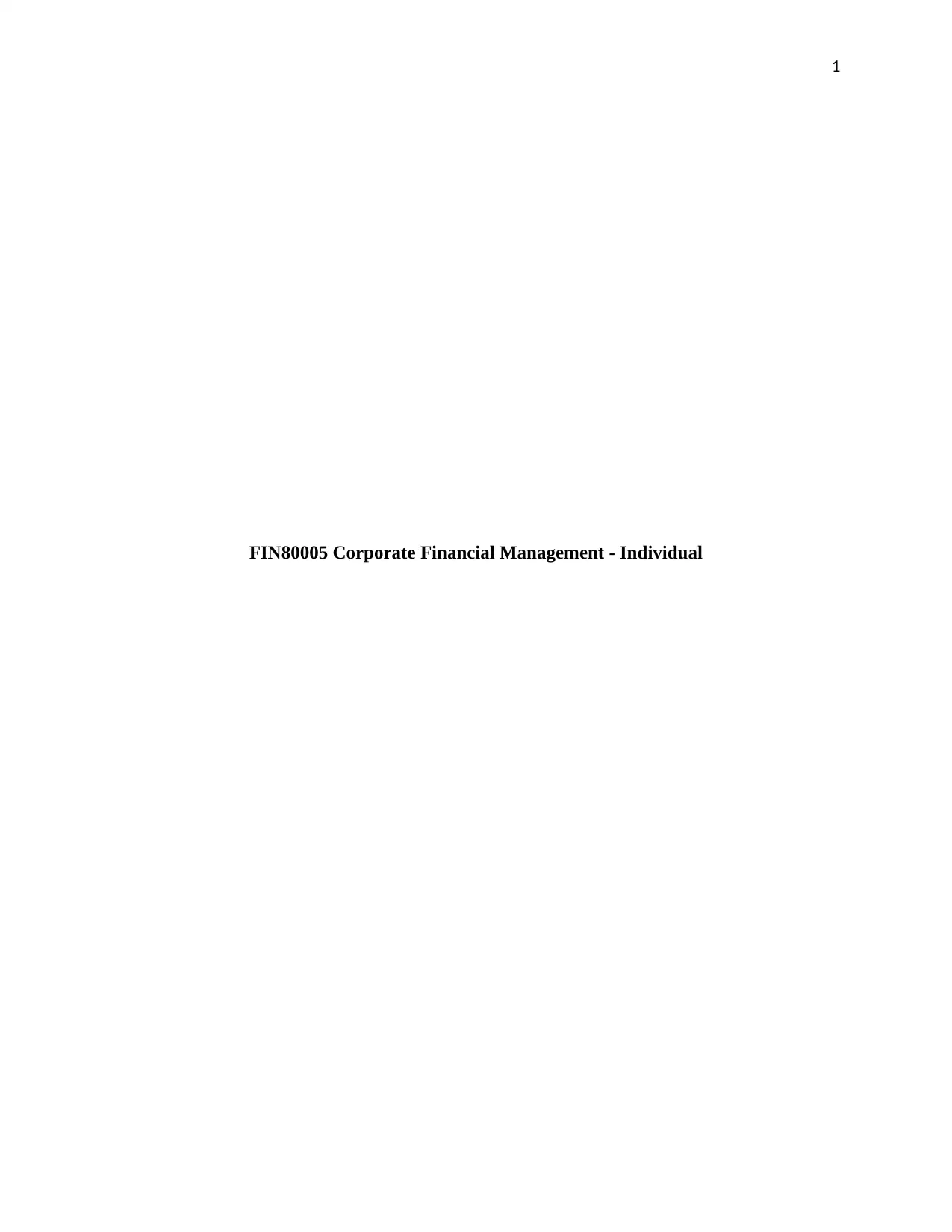
1
FIN80005 Corporate Financial Management - Individual
FIN80005 Corporate Financial Management - Individual
Paraphrase This Document
Need a fresh take? Get an instant paraphrase of this document with our AI Paraphraser
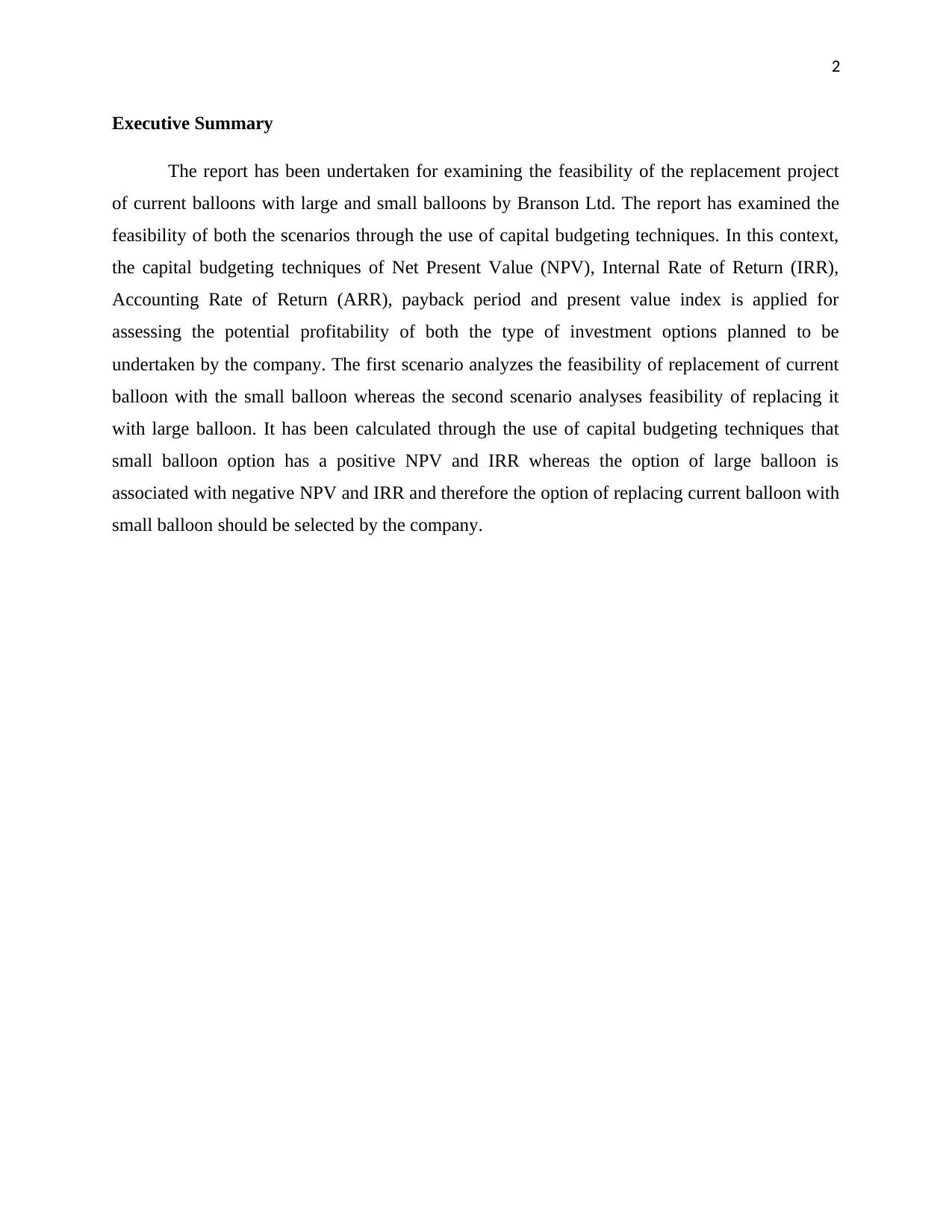
2
Executive Summary
The report has been undertaken for examining the feasibility of the replacement project
of current balloons with large and small balloons by Branson Ltd. The report has examined the
feasibility of both the scenarios through the use of capital budgeting techniques. In this context,
the capital budgeting techniques of Net Present Value (NPV), Internal Rate of Return (IRR),
Accounting Rate of Return (ARR), payback period and present value index is applied for
assessing the potential profitability of both the type of investment options planned to be
undertaken by the company. The first scenario analyzes the feasibility of replacement of current
balloon with the small balloon whereas the second scenario analyses feasibility of replacing it
with large balloon. It has been calculated through the use of capital budgeting techniques that
small balloon option has a positive NPV and IRR whereas the option of large balloon is
associated with negative NPV and IRR and therefore the option of replacing current balloon with
small balloon should be selected by the company.
Executive Summary
The report has been undertaken for examining the feasibility of the replacement project
of current balloons with large and small balloons by Branson Ltd. The report has examined the
feasibility of both the scenarios through the use of capital budgeting techniques. In this context,
the capital budgeting techniques of Net Present Value (NPV), Internal Rate of Return (IRR),
Accounting Rate of Return (ARR), payback period and present value index is applied for
assessing the potential profitability of both the type of investment options planned to be
undertaken by the company. The first scenario analyzes the feasibility of replacement of current
balloon with the small balloon whereas the second scenario analyses feasibility of replacing it
with large balloon. It has been calculated through the use of capital budgeting techniques that
small balloon option has a positive NPV and IRR whereas the option of large balloon is
associated with negative NPV and IRR and therefore the option of replacing current balloon with
small balloon should be selected by the company.

3
Introduction
The present report is developed in order to demonstrate the importance of capital
budgeting techniques used for evaluating the project feasibility. The process of capital budgeting
is used for examining the long-term economic and financial profitability of the investment
project. The capital investment projects to be selected by a business organization involve high
financial risks and therefore the project manager adopts the use of capital budgeting technique
for determining their potential feasibility (Peterson and Fabozzi, 2002). The use of various
capital budgeting techniques such as net present value (NPV), internal rate of return (IRR),
accounting rate of return (ARR), payback period and the present value index helps the project
manager to conduct the systematic analysis of the projects (Bromwich and Bhimani, 2005). This
helps in selection of the investment project that is associated with less risk and will provide
higher returns to the company in future context. As such, the use of above mentioned capital
budgeting techniques is used for evaluating the feasibility of the investment project planned to be
undertaken by Branson Ltd (Higgins, 2012). The company is a publicly listed tour company of
Melbourne involved in providing hot-air balloon flights to the tourists over the city. Branson Ltd
is conserving the adoption of capital investment project for replacing their current balloons with
a large or small model. As such, the company is required to evaluate the various scenarios for
analyzing the capital replacement decision and thus selecting the best possible replacement
option (Besley and Brigham, 2008).
Scenario 1: When investment made in small Balloon
The scenario involves replacing the current balloon with the new balloon and this
potential investment option of the company is likely to incur it a cost of about $800,000 with an
additional installation and shipping costs of $50,000. Also, there will be an additional
requirement of net working capital of about $50,000 for the large model. The company in the
period of high demand is expecting operating revenue of about $650,000 for the large model and
in the condition of low demand it is estimated to be about $300,000. The annual variable and
fixed costs that are associated with the operation of the large balloons are $30,000. However, the
most important concern for the company is that if it selects the investment option of large model
then it needs to rent an additional warehouse for storage purpose and thus will cost the company
around $50,000 and it can realize about $400,000 by selling the large balloons in the condition of
Introduction
The present report is developed in order to demonstrate the importance of capital
budgeting techniques used for evaluating the project feasibility. The process of capital budgeting
is used for examining the long-term economic and financial profitability of the investment
project. The capital investment projects to be selected by a business organization involve high
financial risks and therefore the project manager adopts the use of capital budgeting technique
for determining their potential feasibility (Peterson and Fabozzi, 2002). The use of various
capital budgeting techniques such as net present value (NPV), internal rate of return (IRR),
accounting rate of return (ARR), payback period and the present value index helps the project
manager to conduct the systematic analysis of the projects (Bromwich and Bhimani, 2005). This
helps in selection of the investment project that is associated with less risk and will provide
higher returns to the company in future context. As such, the use of above mentioned capital
budgeting techniques is used for evaluating the feasibility of the investment project planned to be
undertaken by Branson Ltd (Higgins, 2012). The company is a publicly listed tour company of
Melbourne involved in providing hot-air balloon flights to the tourists over the city. Branson Ltd
is conserving the adoption of capital investment project for replacing their current balloons with
a large or small model. As such, the company is required to evaluate the various scenarios for
analyzing the capital replacement decision and thus selecting the best possible replacement
option (Besley and Brigham, 2008).
Scenario 1: When investment made in small Balloon
The scenario involves replacing the current balloon with the new balloon and this
potential investment option of the company is likely to incur it a cost of about $800,000 with an
additional installation and shipping costs of $50,000. Also, there will be an additional
requirement of net working capital of about $50,000 for the large model. The company in the
period of high demand is expecting operating revenue of about $650,000 for the large model and
in the condition of low demand it is estimated to be about $300,000. The annual variable and
fixed costs that are associated with the operation of the large balloons are $30,000. However, the
most important concern for the company is that if it selects the investment option of large model
then it needs to rent an additional warehouse for storage purpose and thus will cost the company
around $50,000 and it can realize about $400,000 by selling the large balloons in the condition of
⊘ This is a preview!⊘
Do you want full access?
Subscribe today to unlock all pages.

Trusted by 1+ million students worldwide
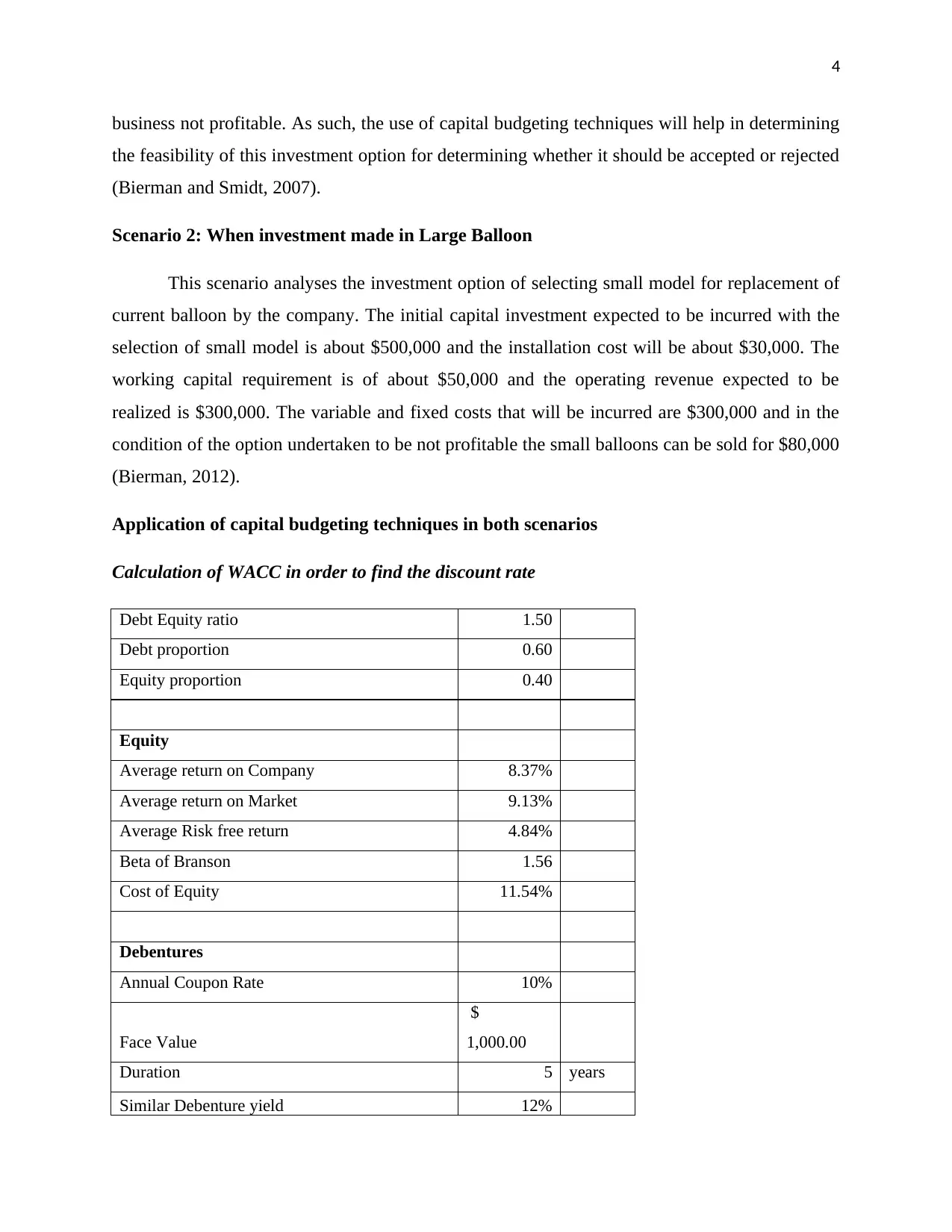
4
business not profitable. As such, the use of capital budgeting techniques will help in determining
the feasibility of this investment option for determining whether it should be accepted or rejected
(Bierman and Smidt, 2007).
Scenario 2: When investment made in Large Balloon
This scenario analyses the investment option of selecting small model for replacement of
current balloon by the company. The initial capital investment expected to be incurred with the
selection of small model is about $500,000 and the installation cost will be about $30,000. The
working capital requirement is of about $50,000 and the operating revenue expected to be
realized is $300,000. The variable and fixed costs that will be incurred are $300,000 and in the
condition of the option undertaken to be not profitable the small balloons can be sold for $80,000
(Bierman, 2012).
Application of capital budgeting techniques in both scenarios
Calculation of WACC in order to find the discount rate
Debt Equity ratio 1.50
Debt proportion 0.60
Equity proportion 0.40
Equity
Average return on Company 8.37%
Average return on Market 9.13%
Average Risk free return 4.84%
Beta of Branson 1.56
Cost of Equity 11.54%
Debentures
Annual Coupon Rate 10%
Face Value
$
1,000.00
Duration 5 years
Similar Debenture yield 12%
business not profitable. As such, the use of capital budgeting techniques will help in determining
the feasibility of this investment option for determining whether it should be accepted or rejected
(Bierman and Smidt, 2007).
Scenario 2: When investment made in Large Balloon
This scenario analyses the investment option of selecting small model for replacement of
current balloon by the company. The initial capital investment expected to be incurred with the
selection of small model is about $500,000 and the installation cost will be about $30,000. The
working capital requirement is of about $50,000 and the operating revenue expected to be
realized is $300,000. The variable and fixed costs that will be incurred are $300,000 and in the
condition of the option undertaken to be not profitable the small balloons can be sold for $80,000
(Bierman, 2012).
Application of capital budgeting techniques in both scenarios
Calculation of WACC in order to find the discount rate
Debt Equity ratio 1.50
Debt proportion 0.60
Equity proportion 0.40
Equity
Average return on Company 8.37%
Average return on Market 9.13%
Average Risk free return 4.84%
Beta of Branson 1.56
Cost of Equity 11.54%
Debentures
Annual Coupon Rate 10%
Face Value
$
1,000.00
Duration 5 years
Similar Debenture yield 12%
Paraphrase This Document
Need a fresh take? Get an instant paraphrase of this document with our AI Paraphraser
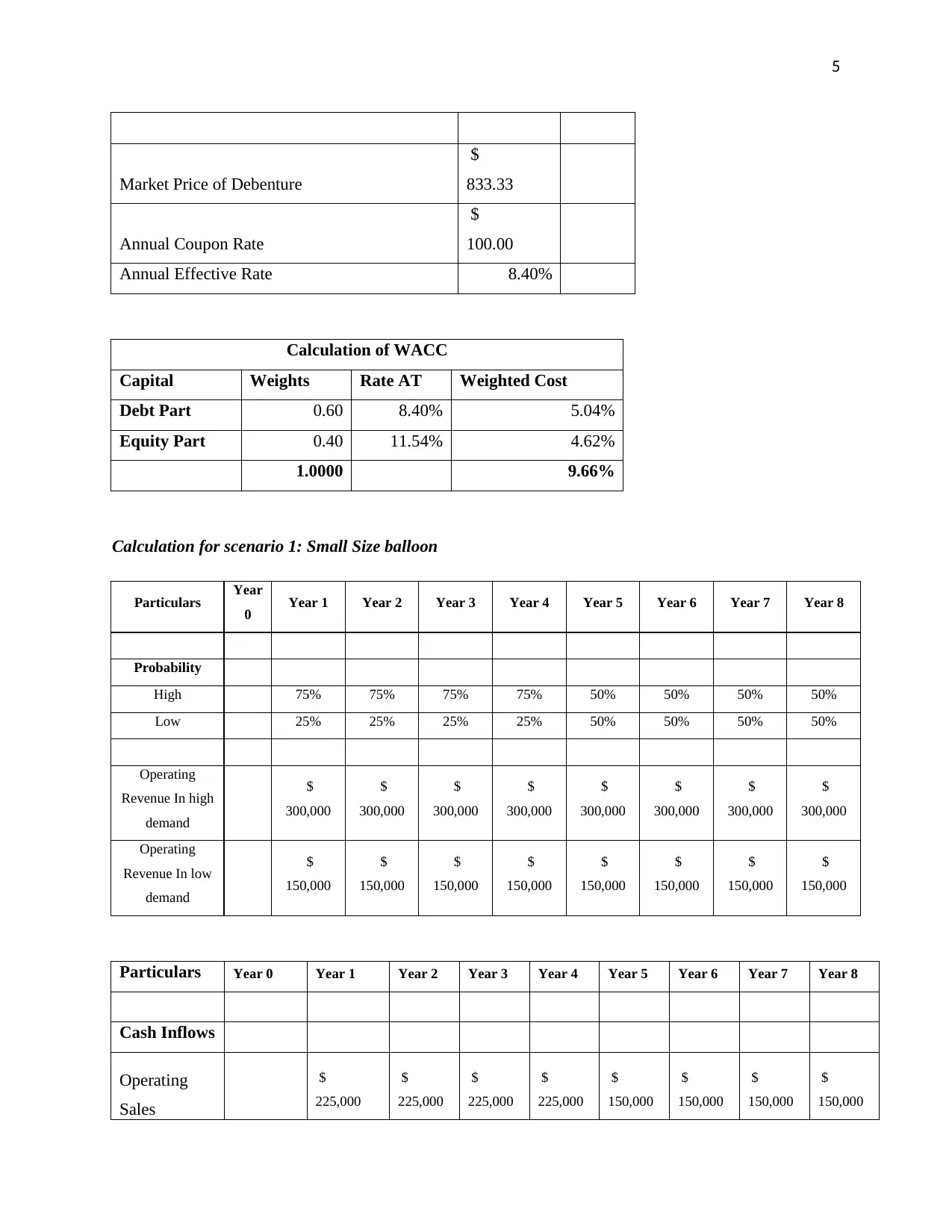
5
Market Price of Debenture
$
833.33
Annual Coupon Rate
$
100.00
Annual Effective Rate 8.40%
Calculation of WACC
Capital Weights Rate AT Weighted Cost
Debt Part 0.60 8.40% 5.04%
Equity Part 0.40 11.54% 4.62%
1.0000 9.66%
Calculation for scenario 1: Small Size balloon
Particulars Year
0 Year 1 Year 2 Year 3 Year 4 Year 5 Year 6 Year 7 Year 8
Probability
High 75% 75% 75% 75% 50% 50% 50% 50%
Low 25% 25% 25% 25% 50% 50% 50% 50%
Operating
Revenue In high
demand
$
300,000
$
300,000
$
300,000
$
300,000
$
300,000
$
300,000
$
300,000
$
300,000
Operating
Revenue In low
demand
$
150,000
$
150,000
$
150,000
$
150,000
$
150,000
$
150,000
$
150,000
$
150,000
Particulars Year 0 Year 1 Year 2 Year 3 Year 4 Year 5 Year 6 Year 7 Year 8
Cash Inflows
Operating
Sales
$
225,000
$
225,000
$
225,000
$
225,000
$
150,000
$
150,000
$
150,000
$
150,000
Market Price of Debenture
$
833.33
Annual Coupon Rate
$
100.00
Annual Effective Rate 8.40%
Calculation of WACC
Capital Weights Rate AT Weighted Cost
Debt Part 0.60 8.40% 5.04%
Equity Part 0.40 11.54% 4.62%
1.0000 9.66%
Calculation for scenario 1: Small Size balloon
Particulars Year
0 Year 1 Year 2 Year 3 Year 4 Year 5 Year 6 Year 7 Year 8
Probability
High 75% 75% 75% 75% 50% 50% 50% 50%
Low 25% 25% 25% 25% 50% 50% 50% 50%
Operating
Revenue In high
demand
$
300,000
$
300,000
$
300,000
$
300,000
$
300,000
$
300,000
$
300,000
$
300,000
Operating
Revenue In low
demand
$
150,000
$
150,000
$
150,000
$
150,000
$
150,000
$
150,000
$
150,000
$
150,000
Particulars Year 0 Year 1 Year 2 Year 3 Year 4 Year 5 Year 6 Year 7 Year 8
Cash Inflows
Operating
Sales
$
225,000
$
225,000
$
225,000
$
225,000
$
150,000
$
150,000
$
150,000
$
150,000
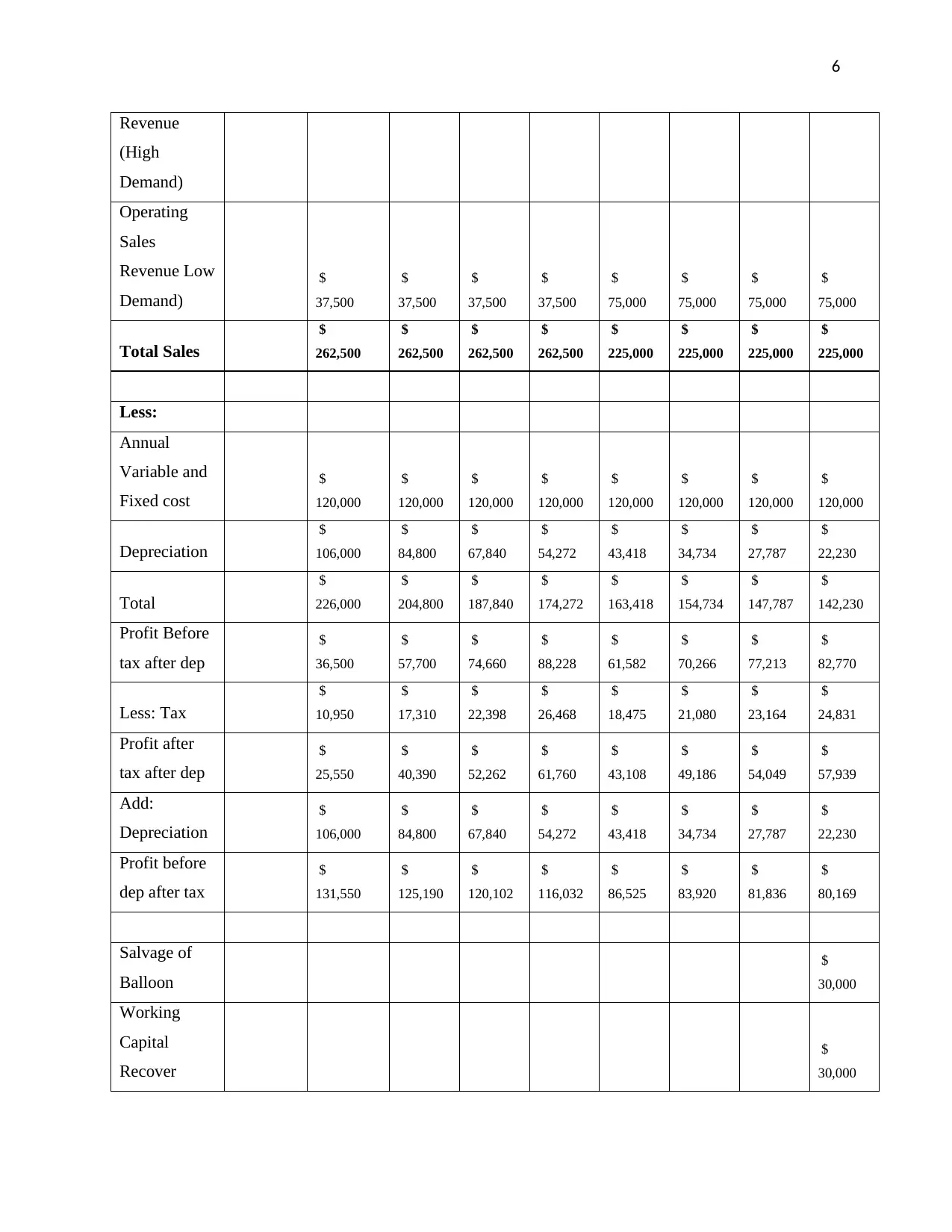
6
Revenue
(High
Demand)
Operating
Sales
Revenue Low
Demand)
$
37,500
$
37,500
$
37,500
$
37,500
$
75,000
$
75,000
$
75,000
$
75,000
Total Sales
$
262,500
$
262,500
$
262,500
$
262,500
$
225,000
$
225,000
$
225,000
$
225,000
Less:
Annual
Variable and
Fixed cost
$
120,000
$
120,000
$
120,000
$
120,000
$
120,000
$
120,000
$
120,000
$
120,000
Depreciation
$
106,000
$
84,800
$
67,840
$
54,272
$
43,418
$
34,734
$
27,787
$
22,230
Total
$
226,000
$
204,800
$
187,840
$
174,272
$
163,418
$
154,734
$
147,787
$
142,230
Profit Before
tax after dep
$
36,500
$
57,700
$
74,660
$
88,228
$
61,582
$
70,266
$
77,213
$
82,770
Less: Tax
$
10,950
$
17,310
$
22,398
$
26,468
$
18,475
$
21,080
$
23,164
$
24,831
Profit after
tax after dep
$
25,550
$
40,390
$
52,262
$
61,760
$
43,108
$
49,186
$
54,049
$
57,939
Add:
Depreciation
$
106,000
$
84,800
$
67,840
$
54,272
$
43,418
$
34,734
$
27,787
$
22,230
Profit before
dep after tax
$
131,550
$
125,190
$
120,102
$
116,032
$
86,525
$
83,920
$
81,836
$
80,169
Salvage of
Balloon
$
30,000
Working
Capital
Recover
$
30,000
Revenue
(High
Demand)
Operating
Sales
Revenue Low
Demand)
$
37,500
$
37,500
$
37,500
$
37,500
$
75,000
$
75,000
$
75,000
$
75,000
Total Sales
$
262,500
$
262,500
$
262,500
$
262,500
$
225,000
$
225,000
$
225,000
$
225,000
Less:
Annual
Variable and
Fixed cost
$
120,000
$
120,000
$
120,000
$
120,000
$
120,000
$
120,000
$
120,000
$
120,000
Depreciation
$
106,000
$
84,800
$
67,840
$
54,272
$
43,418
$
34,734
$
27,787
$
22,230
Total
$
226,000
$
204,800
$
187,840
$
174,272
$
163,418
$
154,734
$
147,787
$
142,230
Profit Before
tax after dep
$
36,500
$
57,700
$
74,660
$
88,228
$
61,582
$
70,266
$
77,213
$
82,770
Less: Tax
$
10,950
$
17,310
$
22,398
$
26,468
$
18,475
$
21,080
$
23,164
$
24,831
Profit after
tax after dep
$
25,550
$
40,390
$
52,262
$
61,760
$
43,108
$
49,186
$
54,049
$
57,939
Add:
Depreciation
$
106,000
$
84,800
$
67,840
$
54,272
$
43,418
$
34,734
$
27,787
$
22,230
Profit before
dep after tax
$
131,550
$
125,190
$
120,102
$
116,032
$
86,525
$
83,920
$
81,836
$
80,169
Salvage of
Balloon
$
30,000
Working
Capital
Recover
$
30,000
⊘ This is a preview!⊘
Do you want full access?
Subscribe today to unlock all pages.

Trusted by 1+ million students worldwide

7
Total Cash
Inflows (A)
$
131,550
$
125,190
$
120,102
$
116,032
$
86,525
$
83,920
$
81,836
$
140,169
Cash
Outflows
Cost of
Balloons
-$
530,000
Working
Capital
-$
30,000
Total Cash
outflows (B)
-$
560,000
Total Cash
flows (A-B)
-$
560,000
$
131,550
$
125,190
$
120,102
$
116,032
$
86,525
$
83,920
$
81,836
$
140,169
PVF @
9.66% 1.0000 0.9119 0.8316 0.7583 0.6915 0.6306 0.5751 0.5244 0.4782
Present
Value
-$
560,000
$
119,962
$
104,105
$
91,076
$
80,239
$
54,563
$
48,259
$
42,915
$
67,029
Net Present
Value
$
48,149
Profitability
Index 1.09
Internal
Rate of
Return 11.87%
Payback
Value 4.41
4 years 5
months
Discounted 6.74 6 years 9
Total Cash
Inflows (A)
$
131,550
$
125,190
$
120,102
$
116,032
$
86,525
$
83,920
$
81,836
$
140,169
Cash
Outflows
Cost of
Balloons
-$
530,000
Working
Capital
-$
30,000
Total Cash
outflows (B)
-$
560,000
Total Cash
flows (A-B)
-$
560,000
$
131,550
$
125,190
$
120,102
$
116,032
$
86,525
$
83,920
$
81,836
$
140,169
PVF @
9.66% 1.0000 0.9119 0.8316 0.7583 0.6915 0.6306 0.5751 0.5244 0.4782
Present
Value
-$
560,000
$
119,962
$
104,105
$
91,076
$
80,239
$
54,563
$
48,259
$
42,915
$
67,029
Net Present
Value
$
48,149
Profitability
Index 1.09
Internal
Rate of
Return 11.87%
Payback
Value 4.41
4 years 5
months
Discounted 6.74 6 years 9
Paraphrase This Document
Need a fresh take? Get an instant paraphrase of this document with our AI Paraphraser
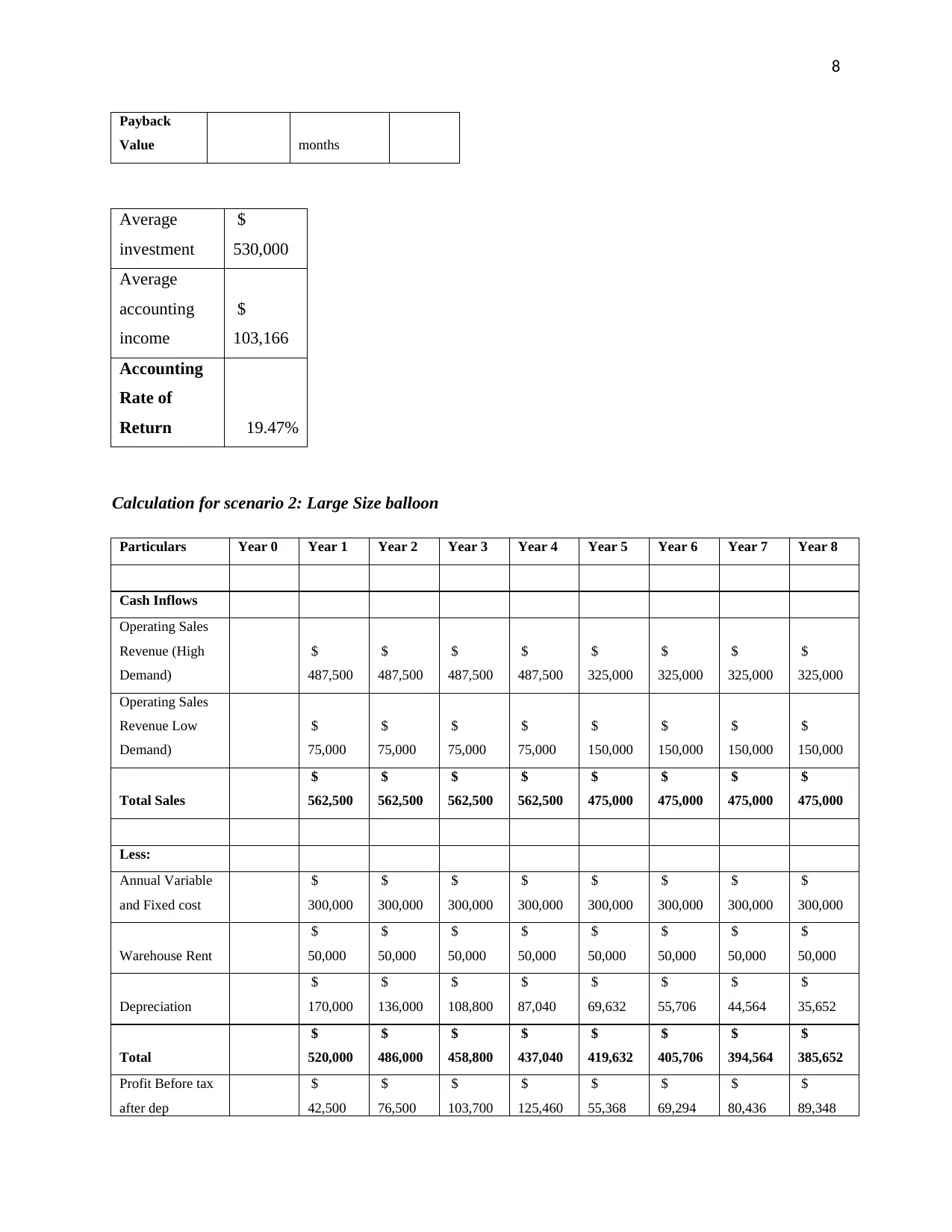
8
Payback
Value months
Average
investment
$
530,000
Average
accounting
income
$
103,166
Accounting
Rate of
Return 19.47%
Calculation for scenario 2: Large Size balloon
Particulars Year 0 Year 1 Year 2 Year 3 Year 4 Year 5 Year 6 Year 7 Year 8
Cash Inflows
Operating Sales
Revenue (High
Demand)
$
487,500
$
487,500
$
487,500
$
487,500
$
325,000
$
325,000
$
325,000
$
325,000
Operating Sales
Revenue Low
Demand)
$
75,000
$
75,000
$
75,000
$
75,000
$
150,000
$
150,000
$
150,000
$
150,000
Total Sales
$
562,500
$
562,500
$
562,500
$
562,500
$
475,000
$
475,000
$
475,000
$
475,000
Less:
Annual Variable
and Fixed cost
$
300,000
$
300,000
$
300,000
$
300,000
$
300,000
$
300,000
$
300,000
$
300,000
Warehouse Rent
$
50,000
$
50,000
$
50,000
$
50,000
$
50,000
$
50,000
$
50,000
$
50,000
Depreciation
$
170,000
$
136,000
$
108,800
$
87,040
$
69,632
$
55,706
$
44,564
$
35,652
Total
$
520,000
$
486,000
$
458,800
$
437,040
$
419,632
$
405,706
$
394,564
$
385,652
Profit Before tax
after dep
$
42,500
$
76,500
$
103,700
$
125,460
$
55,368
$
69,294
$
80,436
$
89,348
Payback
Value months
Average
investment
$
530,000
Average
accounting
income
$
103,166
Accounting
Rate of
Return 19.47%
Calculation for scenario 2: Large Size balloon
Particulars Year 0 Year 1 Year 2 Year 3 Year 4 Year 5 Year 6 Year 7 Year 8
Cash Inflows
Operating Sales
Revenue (High
Demand)
$
487,500
$
487,500
$
487,500
$
487,500
$
325,000
$
325,000
$
325,000
$
325,000
Operating Sales
Revenue Low
Demand)
$
75,000
$
75,000
$
75,000
$
75,000
$
150,000
$
150,000
$
150,000
$
150,000
Total Sales
$
562,500
$
562,500
$
562,500
$
562,500
$
475,000
$
475,000
$
475,000
$
475,000
Less:
Annual Variable
and Fixed cost
$
300,000
$
300,000
$
300,000
$
300,000
$
300,000
$
300,000
$
300,000
$
300,000
Warehouse Rent
$
50,000
$
50,000
$
50,000
$
50,000
$
50,000
$
50,000
$
50,000
$
50,000
Depreciation
$
170,000
$
136,000
$
108,800
$
87,040
$
69,632
$
55,706
$
44,564
$
35,652
Total
$
520,000
$
486,000
$
458,800
$
437,040
$
419,632
$
405,706
$
394,564
$
385,652
Profit Before tax
after dep
$
42,500
$
76,500
$
103,700
$
125,460
$
55,368
$
69,294
$
80,436
$
89,348
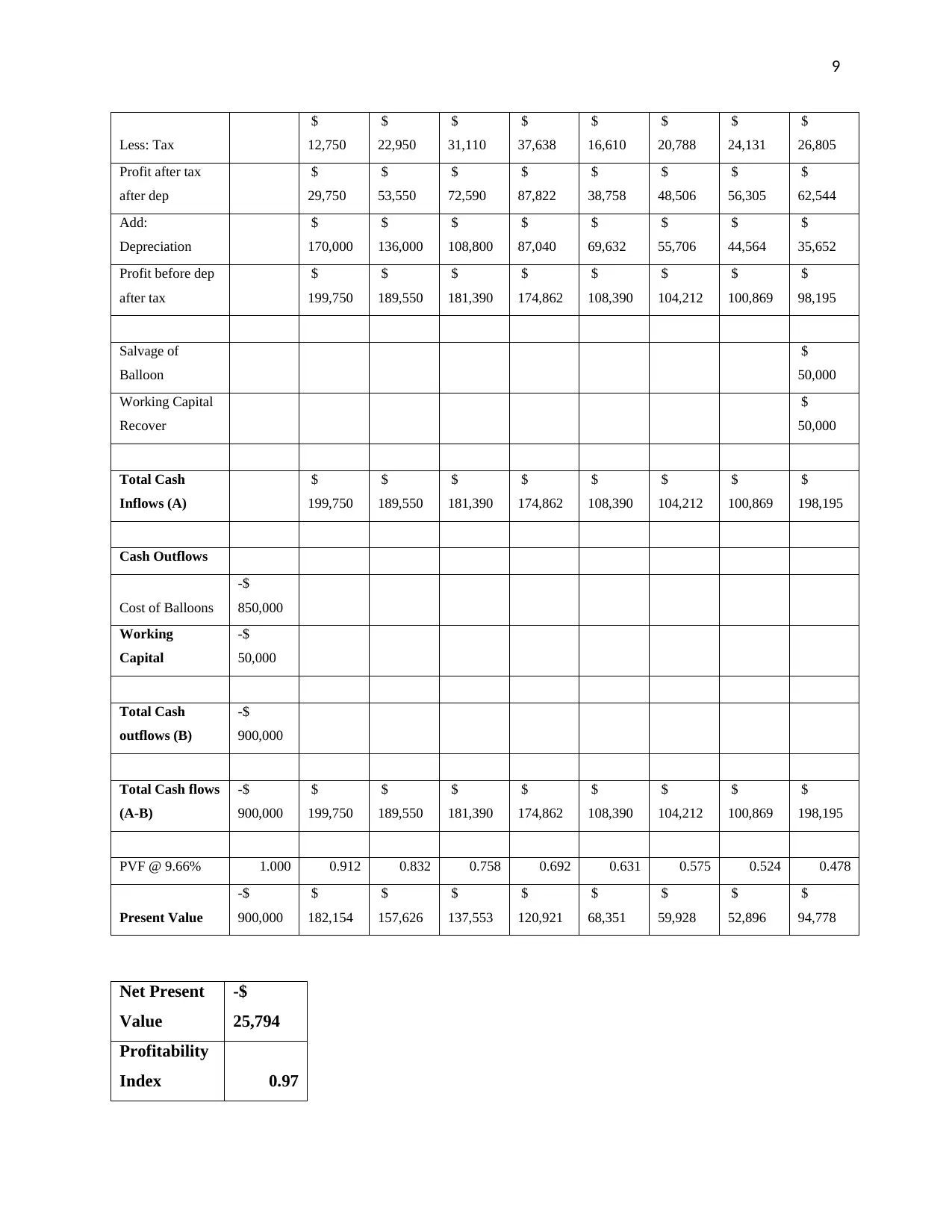
9
Less: Tax
$
12,750
$
22,950
$
31,110
$
37,638
$
16,610
$
20,788
$
24,131
$
26,805
Profit after tax
after dep
$
29,750
$
53,550
$
72,590
$
87,822
$
38,758
$
48,506
$
56,305
$
62,544
Add:
Depreciation
$
170,000
$
136,000
$
108,800
$
87,040
$
69,632
$
55,706
$
44,564
$
35,652
Profit before dep
after tax
$
199,750
$
189,550
$
181,390
$
174,862
$
108,390
$
104,212
$
100,869
$
98,195
Salvage of
Balloon
$
50,000
Working Capital
Recover
$
50,000
Total Cash
Inflows (A)
$
199,750
$
189,550
$
181,390
$
174,862
$
108,390
$
104,212
$
100,869
$
198,195
Cash Outflows
Cost of Balloons
-$
850,000
Working
Capital
-$
50,000
Total Cash
outflows (B)
-$
900,000
Total Cash flows
(A-B)
-$
900,000
$
199,750
$
189,550
$
181,390
$
174,862
$
108,390
$
104,212
$
100,869
$
198,195
PVF @ 9.66% 1.000 0.912 0.832 0.758 0.692 0.631 0.575 0.524 0.478
Present Value
-$
900,000
$
182,154
$
157,626
$
137,553
$
120,921
$
68,351
$
59,928
$
52,896
$
94,778
Net Present
Value
-$
25,794
Profitability
Index 0.97
Less: Tax
$
12,750
$
22,950
$
31,110
$
37,638
$
16,610
$
20,788
$
24,131
$
26,805
Profit after tax
after dep
$
29,750
$
53,550
$
72,590
$
87,822
$
38,758
$
48,506
$
56,305
$
62,544
Add:
Depreciation
$
170,000
$
136,000
$
108,800
$
87,040
$
69,632
$
55,706
$
44,564
$
35,652
Profit before dep
after tax
$
199,750
$
189,550
$
181,390
$
174,862
$
108,390
$
104,212
$
100,869
$
98,195
Salvage of
Balloon
$
50,000
Working Capital
Recover
$
50,000
Total Cash
Inflows (A)
$
199,750
$
189,550
$
181,390
$
174,862
$
108,390
$
104,212
$
100,869
$
198,195
Cash Outflows
Cost of Balloons
-$
850,000
Working
Capital
-$
50,000
Total Cash
outflows (B)
-$
900,000
Total Cash flows
(A-B)
-$
900,000
$
199,750
$
189,550
$
181,390
$
174,862
$
108,390
$
104,212
$
100,869
$
198,195
PVF @ 9.66% 1.000 0.912 0.832 0.758 0.692 0.631 0.575 0.524 0.478
Present Value
-$
900,000
$
182,154
$
157,626
$
137,553
$
120,921
$
68,351
$
59,928
$
52,896
$
94,778
Net Present
Value
-$
25,794
Profitability
Index 0.97
⊘ This is a preview!⊘
Do you want full access?
Subscribe today to unlock all pages.

Trusted by 1+ million students worldwide
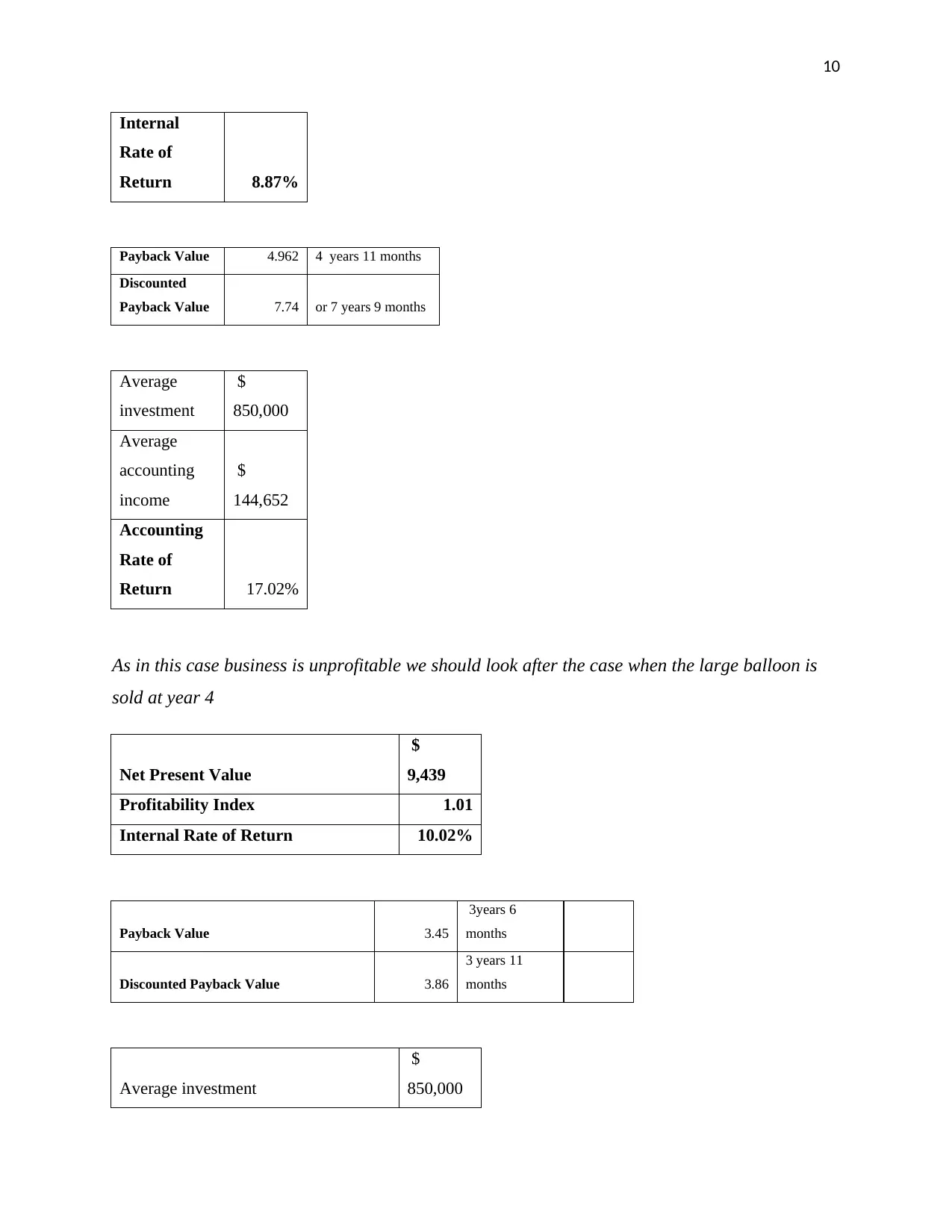
10
Internal
Rate of
Return 8.87%
Payback Value 4.962 4 years 11 months
Discounted
Payback Value 7.74 or 7 years 9 months
Average
investment
$
850,000
Average
accounting
income
$
144,652
Accounting
Rate of
Return 17.02%
As in this case business is unprofitable we should look after the case when the large balloon is
sold at year 4
Net Present Value
$
9,439
Profitability Index 1.01
Internal Rate of Return 10.02%
Payback Value 3.45
3years 6
months
Discounted Payback Value 3.86
3 years 11
months
Average investment
$
850,000
Internal
Rate of
Return 8.87%
Payback Value 4.962 4 years 11 months
Discounted
Payback Value 7.74 or 7 years 9 months
Average
investment
$
850,000
Average
accounting
income
$
144,652
Accounting
Rate of
Return 17.02%
As in this case business is unprofitable we should look after the case when the large balloon is
sold at year 4
Net Present Value
$
9,439
Profitability Index 1.01
Internal Rate of Return 10.02%
Payback Value 3.45
3years 6
months
Discounted Payback Value 3.86
3 years 11
months
Average investment
$
850,000
Paraphrase This Document
Need a fresh take? Get an instant paraphrase of this document with our AI Paraphraser
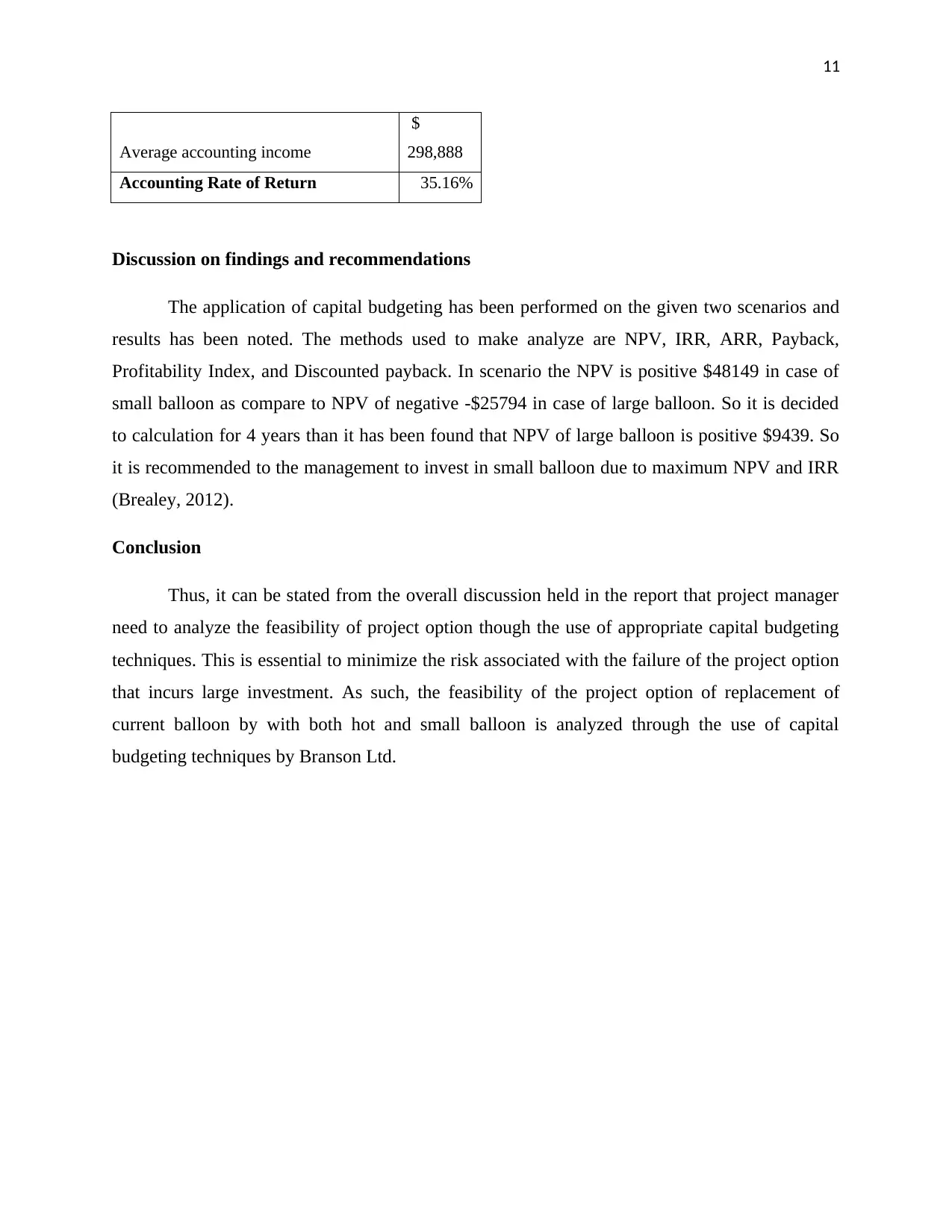
11
Average accounting income
$
298,888
Accounting Rate of Return 35.16%
Discussion on findings and recommendations
The application of capital budgeting has been performed on the given two scenarios and
results has been noted. The methods used to make analyze are NPV, IRR, ARR, Payback,
Profitability Index, and Discounted payback. In scenario the NPV is positive $48149 in case of
small balloon as compare to NPV of negative -$25794 in case of large balloon. So it is decided
to calculation for 4 years than it has been found that NPV of large balloon is positive $9439. So
it is recommended to the management to invest in small balloon due to maximum NPV and IRR
(Brealey, 2012).
Conclusion
Thus, it can be stated from the overall discussion held in the report that project manager
need to analyze the feasibility of project option though the use of appropriate capital budgeting
techniques. This is essential to minimize the risk associated with the failure of the project option
that incurs large investment. As such, the feasibility of the project option of replacement of
current balloon by with both hot and small balloon is analyzed through the use of capital
budgeting techniques by Branson Ltd.
Average accounting income
$
298,888
Accounting Rate of Return 35.16%
Discussion on findings and recommendations
The application of capital budgeting has been performed on the given two scenarios and
results has been noted. The methods used to make analyze are NPV, IRR, ARR, Payback,
Profitability Index, and Discounted payback. In scenario the NPV is positive $48149 in case of
small balloon as compare to NPV of negative -$25794 in case of large balloon. So it is decided
to calculation for 4 years than it has been found that NPV of large balloon is positive $9439. So
it is recommended to the management to invest in small balloon due to maximum NPV and IRR
(Brealey, 2012).
Conclusion
Thus, it can be stated from the overall discussion held in the report that project manager
need to analyze the feasibility of project option though the use of appropriate capital budgeting
techniques. This is essential to minimize the risk associated with the failure of the project option
that incurs large investment. As such, the feasibility of the project option of replacement of
current balloon by with both hot and small balloon is analyzed through the use of capital
budgeting techniques by Branson Ltd.
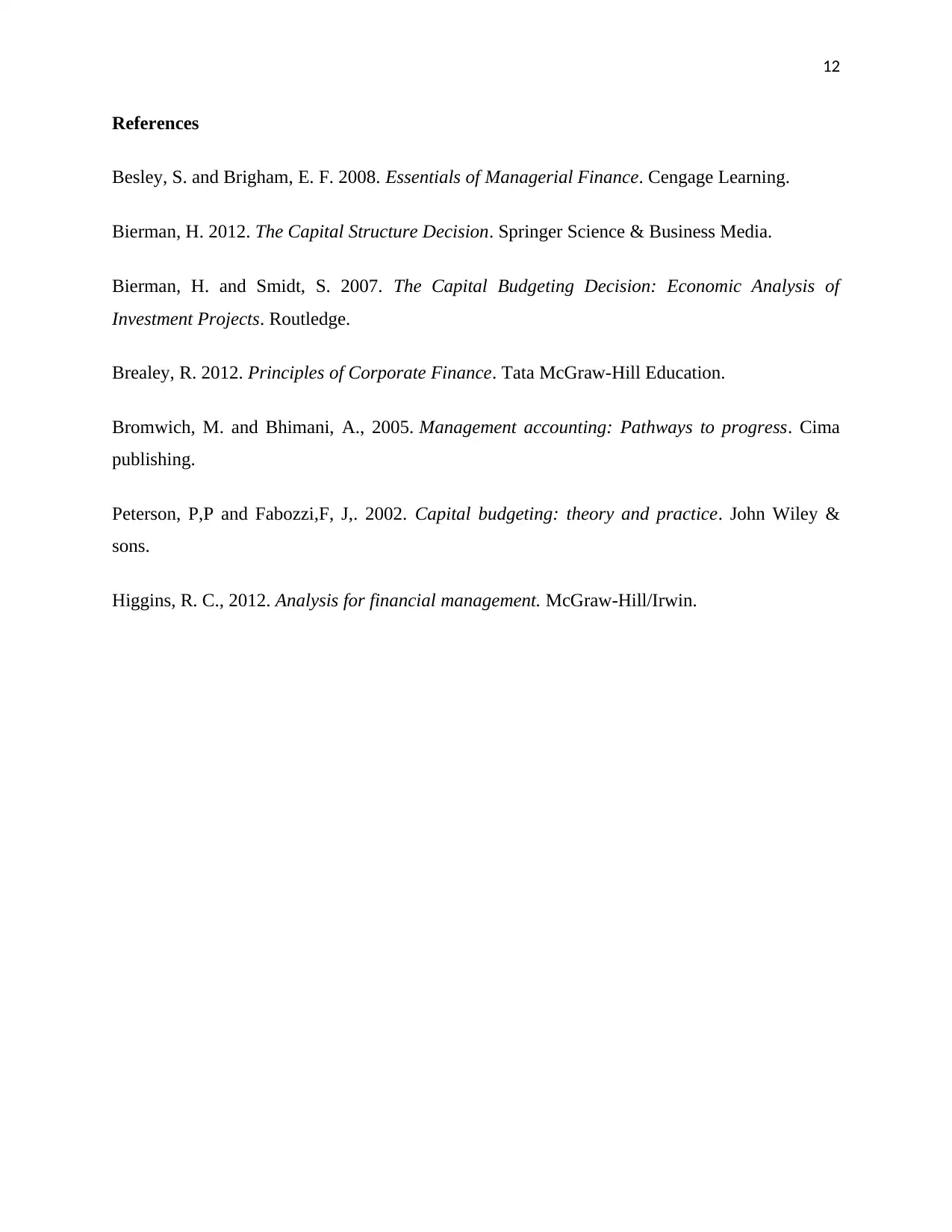
12
References
Besley, S. and Brigham, E. F. 2008. Essentials of Managerial Finance. Cengage Learning.
Bierman, H. 2012. The Capital Structure Decision. Springer Science & Business Media.
Bierman, H. and Smidt, S. 2007. The Capital Budgeting Decision: Economic Analysis of
Investment Projects. Routledge.
Brealey, R. 2012. Principles of Corporate Finance. Tata McGraw-Hill Education.
Bromwich, M. and Bhimani, A., 2005. Management accounting: Pathways to progress. Cima
publishing.
Peterson, P,P and Fabozzi,F, J,. 2002. Capital budgeting: theory and practice. John Wiley &
sons.
Higgins, R. C., 2012. Analysis for financial management. McGraw-Hill/Irwin.
References
Besley, S. and Brigham, E. F. 2008. Essentials of Managerial Finance. Cengage Learning.
Bierman, H. 2012. The Capital Structure Decision. Springer Science & Business Media.
Bierman, H. and Smidt, S. 2007. The Capital Budgeting Decision: Economic Analysis of
Investment Projects. Routledge.
Brealey, R. 2012. Principles of Corporate Finance. Tata McGraw-Hill Education.
Bromwich, M. and Bhimani, A., 2005. Management accounting: Pathways to progress. Cima
publishing.
Peterson, P,P and Fabozzi,F, J,. 2002. Capital budgeting: theory and practice. John Wiley &
sons.
Higgins, R. C., 2012. Analysis for financial management. McGraw-Hill/Irwin.
⊘ This is a preview!⊘
Do you want full access?
Subscribe today to unlock all pages.

Trusted by 1+ million students worldwide
1 out of 12
Related Documents
Your All-in-One AI-Powered Toolkit for Academic Success.
+13062052269
info@desklib.com
Available 24*7 on WhatsApp / Email
![[object Object]](/_next/static/media/star-bottom.7253800d.svg)
Unlock your academic potential
Copyright © 2020–2025 A2Z Services. All Rights Reserved. Developed and managed by ZUCOL.





